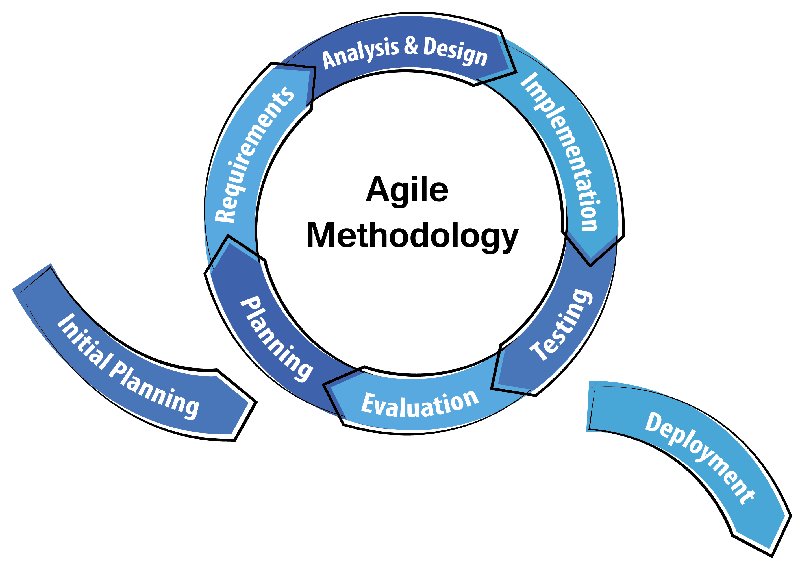![]()
Agile scrum methodology is one of the most commonly used practices in project management in today’s time. The benefits that the method comes with such as increased business value, faster go to market, greater transparency among the team, and better quality management is enough to push a number of businesses across a range of industries to follow the Agile development Scrum approach in their everyday work process.
If your business, seeing the benefits that the methodology has to offer, is also planning to take the agile scrum development route, this article is for you.
But before getting further into the topic, you should first understand what is agile methodology?
Interestingly, there is a slight difference between agile vs scrum if we speak of them individually. Strictly speaking, Agile is a development methodology based on incremental and iterative approach. Whereas, Scrum is just an implementation or a type of agile methodology. Here, incremental builds are passed to the clients bi-weekly.
Meaning, an agile methodology for application development starts by outlining the users and documenting a statement on a scope of problems, opportunities, and values to be addressed. This vision is then caught by the product owner who works with different teams to provide quality end results.
Now that we are clear on the basic difference between agile vs scrum, there is something else that you need to consider before adopting distributed agile development methodology. Let us first touch bases on what Agile Methodology Scrum actually stands for and how it single-handedly brings the model miles ahead in the Agile vs Waterfall debate.
What is Agile Scrum Method in context of Mobile App Development?

Holistically, the role of Agile in mobile apps is well-renowned and Scrum is the most commonly used sub domain of the agile methodology, which has quickly expanded to handling big and complicated projects that might have otherwise taken a lot of time to finish.
When it comes to the role of using agile project management on mobile application development then one needs to take into account that the mobile application developers make an app for a device with a small screen, less memory and less processing speed. Thus, the use of agile and scrum methodology includes programming, development and project management with breakdown of the software development life cycle into smaller modules.
Used mostly by mobile application development services companies or agile software development company, the scrum team breaks down their allotted work aka product backlogs in actions, which they could cover within the two-week cycles, also known as – “sprints.” By completing every sprint, the team is expected to produce a working mobile app, which they continue to work upon and improve.
Every sprint comes with a timeline that extends from 2 months to maximum 4 months. And each of them have these following components to make the agile mobile app development process more efficient –
1. Scrum Roles

How effectively you run an Agile Distributed team is dependent a lot on how well you distribute the roles?
Product Owner – The person is responsible for overlooking what the team is working on and is also responsible for ensuring that the backlog is up to date. The communication of the end customer and team members are also looked at by them.
Scrum Master – He is the one who is assigned to ensure that the agile scrum is followed rightly by the team. They are also responsible for overlooking how the team is performing and resolving any issue that is coming up.
Scrum team – They are the ones who are actually doing the tasks. They own the development and testing part of the whole project and for this purpose the team is said to be self-organized, cross functional, and agile.
2. Product Backlog

Handled by the product owner, product backlog is a list of tasks that the team needs to perform. The modifications and priorities are set as and when needed. The backlog contains various documents which are continuously updated and used when required.
The idea is to have a list of backlogs ready before the sprint starts.
3. Agile Sprint Backlog and Planning

In this scrum project management methodology step, the mobile app development team decides on the backlogs they will be targeting in the current sprint. Sprint backlog is the list of things the team plans on achieving in the delivery. Usually, sprint backlogs are divided into workable actions and once the team agrees upon the backlog items, the sprint begins.
4. Daily Scrum Meeting

Once the above steps of agile application development are done and the team starts working on the product backlogs, a practice called daily scrum is initiated. A stand up daily meeting is held every day for 15 minutes. In the daily scrum everyone in the team tells about the last day’s work and the day’s plan. The daily scrum lets everyone in the team know of the whole project’s progress.
5. Agile Sprint Review
After every agile sprint, the team demonstrates what was developed to the stakeholders and look into the steps where they got stuck and which went well. The findings of one sprint becomes the action statement of the next.
6. Increment
The end result of a scrum is called Increment. The aim of everyone involved in a scrum is to deliver an increment that is complete on its own.It should adhere to all the quality standards set by the product owner and team.
7. Learn. Repeat. Improve.

This entire cycle is repeated in the next sprint.
Sprint Planning chooses the next set of items in the Product Backlog and the sprint cycle starts again. As the team executes the Sprint, the Agile Product Owner simultaneously ensures that the items which are on top of the product backlog are executed first in the next Sprint.
The short, iterative cycle offers the team a lot of opportunities for learning and improving.
How Does Agile Scrum Methodology Makes Mobile App Development Efficient?
Unlike usual desktop applications for PC that may work for a couple of years without any redesign, upgrade, etc., mobile apps ought to be significantly more flexible and adaptable for users. Users’ requests may change rather regularly, thus app owners should update the app each time when it requires new changes. Furthermore, the best approach to make a top notch mobile application without extra revisions is to opt for an agile development company.
1. Improves the Mobile App Quality
Since testing and QA is integrated at every sprint throughout the agile scrum process, the app is checked at all stages, ensuring that it is developed according to the set quality standard, thus sealing its future in terms of high performance and acceptance.
2. Greater Client Satisfaction

Since Agile Method is based on involving the clients at every point, they have a clear access to the app progress, as they are given an app demo with every set of newly added features after every sprint.
3. Greater Transparency

Since the practice of agile methodology is based on involving everyone who is a part of the mobile app development process plus the client, everyone knows the exact work that is to be done and its status.
4. Faster Return on Investment

One of the perks that come associated with Agile software development is Faster development and ROI. With the help of Agile, app development companies are able to start the development process much faster, and are able to take up multiple areas of the process at the same time. Add this with the ease of testing the app function by function on the go, and you will get an expedited app development timeline.
5. Rapid Changes
With the use of agile project management with scrum for mobile app development, it is handy to make changes in apps due to the presence of sprints. The best part is that there is no negative impact on the development as the scrum agile development methodology avoids the problem of revision, time and cost.
Now that you know what agile scrum development process stands for and what are the advantages of Scrum, let us now move on to the factors that you need to consider before you adopt it in your mobile app development branch.
Factors that You Should Consider Before Implementing Agile Scrum in Your Mobile App Development Process
1. Do you have a person in your team who can fill in the role of a scrum master?

This is one of the crucial components of agile scrum development. Before you even move on with the Agile scrum methodology, you will have to appoint a scrum master who would be overlooking all the development processes and the challenges that the team faces. The scrum master will be responsible for gathering requirements from the end users. He will also be responsible for holding the scrum meetings and managing the backlogs.
The role of a scrum master is a very crucial one when it comes to development using the Agile methodology. He would be single handedly responsible for the easy completion of the project.
2. Is your team’s role and responsibilities clear?
The success of your mobile app development process based on agile scrum development methodology depends entirely on how clear your team is with the roles they have to play and how willing they are to handle their part independently. If the individual team members are not comfortable with their roles, the project will face a number of execution challenges and you will never be able to take the full advantage of the agile scrum methodology.
3. Will the Agile Scrum Method actually work for your industry?
One of the rules of the agile scrum that we adhere to before even we start working on an agile approach is gauge if it’s necessary at all. Even though Agile Scrum framework is used by a number of industries globally, it is not fit for all the industry types.
The development method works best for small size teams who handle scrum project management with unknown solutions, varying deliverables, and constant interaction with the end users or clients, which makes it ideal for projects that deal in marketing, software development, supply chain silos, or strategic planning.
Processes like accounting, sales, and even the purchasing domain, which deals with established processes or static deliverables won’t really benefit from it. But companies like Software Development, IT, Operations, Marketing, etc., do practice agile and the rate at which they are adapting is increasing at a fast pace.
In the end, if you understand the benefits that agile scrum development methodology will bring with it and you are prepared to change your work process around it, go ahead with it. But ensure that you have got your stakeholders and team on board with the idea.
What are the Agile Scrum process best practices?

1. Always create product backlog and vision together
So what is a product backlog? Well, it is a list of items needed to be added to product development. Now, it is advised to make the product backlog and product vision together because this way, developers and stakeholders both are in the loop and aware of everything.
2. Employ burndown charts for sprints
In order to track the progress of sprints, the experts at Anteelo suggest that you should use burnout charts. They graphically show the amount of work that has been done. What is more, these charts also help in identifying certain risks related to undelivered work.
3. Establish communication guidelines
If there is one thing that can greatly affect the workflow, it is uninterrupted communication. If not tackled, it becomes one of the greatest challenges of scaling agile practices. There is one thing that can be done – develop a communication strategy based on the guidelines for the teams. This is something that can prove to be very useful for remote teams in making their process transparent.
4. Practice stand-ups
A project/product development process speeds up once every member of the team is on the same page and knows the progress of work. These stand-up meetings are also known as ‘daily scrum’ held at the starting of the working day and last for no more than 15 minutes.
Frequently Asked Questions
1. Why use agile scrum methodology?
Agile Scrum methodology is beneficial in the app development process if done right and religiously. It helps in improving mobile app quality, increases client satisfaction, gives immediate ROI, promotes transparency, and so much more.
2. Who Uses Agile Scrum Methodology?
Almost all the companies irrespective of the industry domain take benefits of agile scrum methodology in order to make the management and process more transparent and smooth.
3. What is Scrum methodology in relation to Agile Project Management?
Scrum is a part of the agile project management methodology which includes a team managed by a Scrum Master. The main job of a Scrum Master is to clear away all obstacles to the team completing work.
Here, the work is done in short cycles known as sprints, and a meeting is arranged including the whole team on a daily basis daily to discuss current tasks and roadblocks that need clearing.







